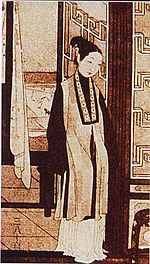Bijia
| Bijia | |||||||
|---|---|---|---|---|---|---|---|
 A woman wearing aMing dynastybijia. | |||||||
| Chinese | Bỉ giáp | ||||||
| |||||||
Bijia(Chinese:Bỉ giáp) is a long, sleeveless jacket ofMongolorigins which has opened side slits.[1]: 46, 68 The bijia started to be worn in theYuan dynastywhen it was designed byEmpress Chabi.[2]Thebijiaeventually became one of the most typical form of women's clothing item in theMing dynasty[3]and in theQing dynasty.[4]It is also a type ofhanfuwhich has been revived in present days.[5]
History[edit]
Yuan dynasty[edit]
The bijia originated from a long-length Mongolvest.[1]: 46 [6]According to theYuan shi,the invention of bijiia is attributed toEmpress Chabiduring theYuan dynasty.[2][7]Empress Chabi designed the bijia so that it would be a convenient form of attire while riding horses and shooting arrows.[2]The front region of the bijia designed by Empress Chabi was made of 1-piece of fabric, and its back region was twice longer than the front region.[2][7][8]It was collarless and sleeveless, and there were two loop straps which attached to it.[2][7][8]It also had no lapels.[8]The bijia was first worn by the Yuan dynasty emperor but it later became popular among commoners.[9]
Ming dynasty[edit]
After the fall of the Yuan dynasty,Mongol fashion of the Yuan dynastycontinued to influence some styles of clothing worn in theMing dynasty;this included the persisting usage of bijia.[1]: 46 [6]The bijia became a type of women clothing in the Ming dynasty, and by the middle of the Ming dynasty it had become a favourite form of dress for women, especially young women.[9]
In theMing dynasty,the bijia was long in length and would reach below the knee level.[3]It was embroidered on woven textile and a jade ornament would be attached at the front of the bijia as a front closure.[3]Bijia created an illusion of slenderness, which women in the Ming dynasty sought after.[3]
Qing dynasty[edit]
In theQing dynasty,Han Chinesewomen were allowed to continue theMing dynastyclothing customs.[4]The bijia remained very popular in Qing dynasty,[9]and it was one of the most common forms of female clothing worn in the 17th and 18th century.[4]
-
Woman wearing bijia (right). Woman wearingbeizi(left). From the paintingAmorous Meeting in a Room Interior,late 18th century Qing Dynasty.
21st Century[edit]
In the 21st century, the bijia regained popularity and is widely worn as ahanfuitem.[10]
-
Woman wearing a long, yellow bijia (middle), 2020.
Influences and derivatives[edit]
Theatrical beixin[edit]
The Chinese operabeixin(Chinese:Bối tâm), also known askanjian,majia,andbeida,were sleevelessvestswhich originated from both theMing dynasty'slong-length bijia worn by women from the lower-middle class and from theQing dynasty'smajia (Chinese:Mã giáp),[11]a type of vest which were worn by theManchu.[12]
-
Theatrical beixin for a female Buddhist priest (front view).
-
Theatrical beixin for a female Buddhist priest (back view).
Majia[edit]
The majia (Chinese:Mã giáp), the sleeveless riding vest of the Qing dynasty, evolved from the bijia which was popular among women during the Ming and Qing dynasties.[9][13]
-
Sleeveless Jacket with Flowering Vine Pattern and Bands (front), late 19th–early 20th century
-
Sleeveless Jacket with Flowering Vine Pattern and Bands (back), late 19th–early 20th century
-
Sleeveless Jacket, 19th century.
Similar looking garments[edit]
- Banbi
- Song dynasty beixin - Sleeveless and translucent vests, which became a popular female fashion in the Southern Song.[14]: 265–266
- Dahu
- Zhaojia( tráo giáp )
- Baeja- A sleeveless or very short-sleeved vest in Korea
-
Beixin, Song dynasty
-
Zhaojia, Ming dynasty
See also[edit]
References[edit]
- ^abcFinnane, Antonia (2008).Changing clothes in China: fashion, history, nation.New York: Columbia University Press.ISBN978-0-231-14350-9.OCLC84903948.
- ^abcdeZhao, George Qingzhi (2008).Marriage as political strategy and cultural expression: Mongolian royal marriages from world empire to Yuan dynasty.New York: Peter Lang Pub. pp. 240–241.ISBN978-1-4331-0275-2.OCLC192134589.
- ^abcdHua, Mei (2011).Chinese clothing(Updated ed.). Cambridge, United Kingdom: Cambridge University Press. p. 41.ISBN978-0-521-18689-6.OCLC781020660.
- ^abcWang, Anita Xiaoming (2018)."The Idealised Lives of Women: Visions of Beauty in Chinese Popular Prints of the Qing Dynasty".Arts Asiatiques.73:61–80.doi:10.3406/arasi.2018.1993.ISSN0004-3958.JSTOR26585538.
- ^"A Brief History of Chinese Outfit for Girl - Bijia (vest) - 2021".www.newhanfu.com.2020-02-16.Archivedfrom the original on 2021-02-26.Retrieved2021-06-23.
- ^abSchlesinger, Jonathan (2017).A world trimmed with fur: wild things, pristine places, and the natural fringes of Qing rule.Stanford, California. p. 31.ISBN978-1-5036-0068-3.OCLC949669739.
{{cite book}}:CS1 maint: location missing publisher (link) - ^abcShea, Eiren L. (2020).Mongol court dress, identity formation, and global exchange.New York, NY. p. 89.ISBN978-0-429-34065-9.OCLC1139920835.
{{cite book}}:CS1 maint: location missing publisher (link) - ^abcLee, Lily Xiao Hong (2015).Biographical Dictionary of Chinese Women, Volume II: Tang Through Ming 618-1644.Sue Wiles. Hoboken: Taylor and Francis. p. 25.ISBN978-1-317-51562-3.OCLC905984401.
- ^abcd5000 years of Chinese costumes.Xun Zhou, Chunming Gao, chu tấn, Shanghai Shi xi qu xue xiao. Zhongguo fu zhuang shi yan jiu zu. San Francisco, CA: China Books & Periodicals. 1987. p. 164.ISBN0-8351-1822-3.OCLC19814728.
{{cite book}}:CS1 maint: others (link) - ^"A Brief History of Chinese Outfit for Girl - Bijia (vest) - 2021".www.newhanfu.com.2020-02-16.Archivedfrom the original on 2021-02-26.Retrieved2021-07-03.
- ^Ye, Tan (2020).Historical dictionary of Chinese theater(Second ed.). Lanham. p. 352.ISBN978-1-5381-2064-4.OCLC1128888776.
{{cite book}}:CS1 maint: location missing publisher (link) - ^"Woman's domestic vest (majia)".collections.mfa.org.Retrieved2021-07-30.
- ^Li, Jinzhao (2005).Constructing Chinese America in Hawaiʻi: the Narcissus Festival, ethnic identity, and community transformation, 1949-2005(Thesis thesis).hdl:10125/12055.
- ^Kuhn, Dieter (2009).The age of Confucian rule: the Song transformation of China.Cambridge, Mass.: Belknap Press of Harvard University Press.ISBN978-0-674-03146-3.OCLC192050158.









